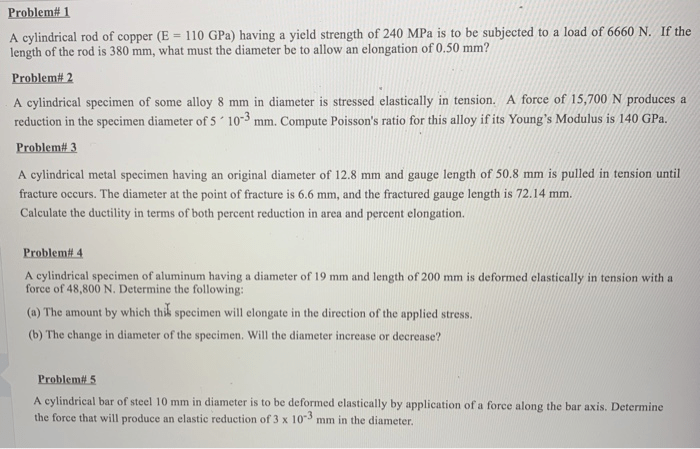A cylindrical rod of copper e 110 gpa – A cylindrical rod of copper with a Young’s Modulus (E) of 110 GPa exhibits remarkable mechanical properties, making it a valuable material in various engineering applications. This article delves into the concept of Young’s Modulus, the characteristics of copper, the geometry of cylindrical rods, and the applications of cylindrical copper rods.
Young’s Modulus, a measure of a material’s stiffness, plays a crucial role in determining the material’s response to applied forces. It is defined as the ratio of stress to strain and provides insights into the material’s ability to resist deformation.
Copper, known for its high electrical and thermal conductivity, also possesses excellent mechanical properties, including high strength and ductility.
Definition of Young’s Modulus (E): A Cylindrical Rod Of Copper E 110 Gpa
Young’s Modulus, denoted by E, is a measure of a material’s stiffness or resistance to deformation under tensile or compressive stress. It is defined as the ratio of stress to strain within the elastic region of a material’s stress-strain curve.
Mathematically, Young’s Modulus is expressed as:
E = σ/ε
where:
- E is Young’s Modulus
- σ is stress (force per unit area)
- ε is strain (change in length per unit length)
Characteristics of Copper

Copper is a reddish-brown metal with excellent electrical and thermal conductivity. It is highly ductile and malleable, making it easy to shape and form.
Copper is also resistant to corrosion, which makes it suitable for a wide range of applications, including electrical wiring, plumbing, and heat exchangers.
Cylindrical Rod Shape
A cylindrical rod is a solid object with a circular cross-section. It is characterized by its length and diameter.
The cross-sectional area of a cylindrical rod is given by:
A = πr²
where:
- A is the cross-sectional area
- r is the radius of the rod
Young’s Modulus of a Cylindrical Copper Rod
![]()
The Young’s Modulus of a cylindrical copper rod can be calculated using the following formula:
E = (4F·L)/(πd²·ΔL)
where:
- E is Young’s Modulus
- F is the applied force
- L is the original length of the rod
- d is the diameter of the rod
- ΔL is the change in length
The Young’s Modulus of copper is approximately 110 GPa.
Applications of Cylindrical Copper Rods

Cylindrical copper rods are used in a wide range of applications, including:
- Electrical wiring
- Plumbing
- Heat exchangers
Copper is a suitable material for these applications due to its high electrical and thermal conductivity, corrosion resistance, and malleability.
Q&A
What is the significance of Young’s Modulus?
Young’s Modulus quantifies a material’s stiffness, indicating its resistance to deformation under applied forces.
Why is copper a suitable material for cylindrical rods?
Copper’s high strength, ductility, electrical conductivity, and corrosion resistance make it an excellent choice for cylindrical rods.
What are the applications of cylindrical copper rods?
Cylindrical copper rods are used in electrical wiring, plumbing, heat exchangers, and other applications where high electrical conductivity and mechanical strength are required.